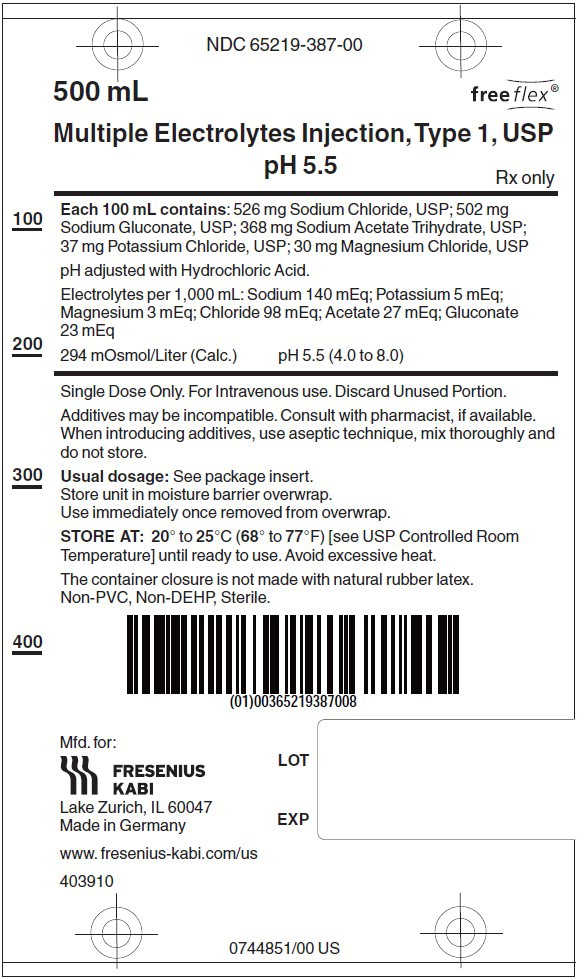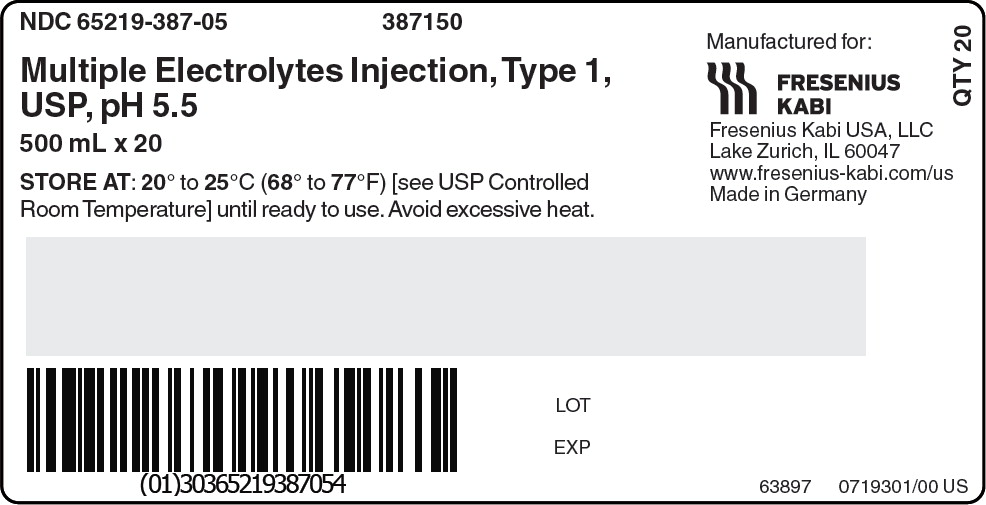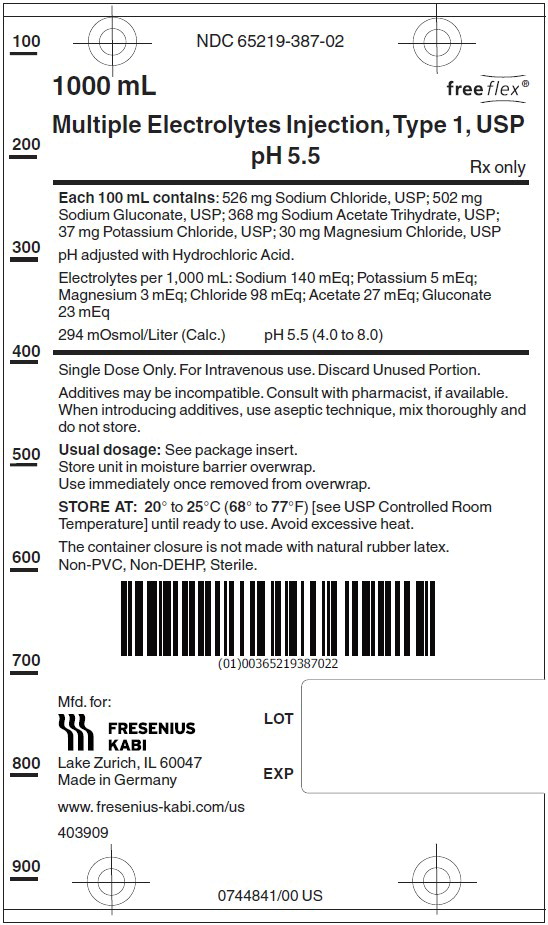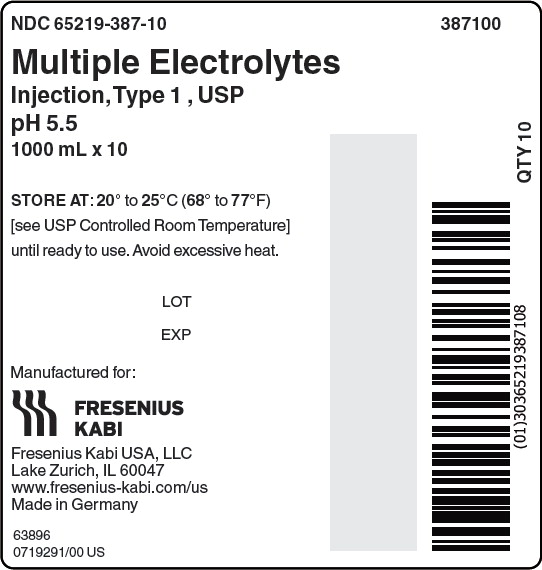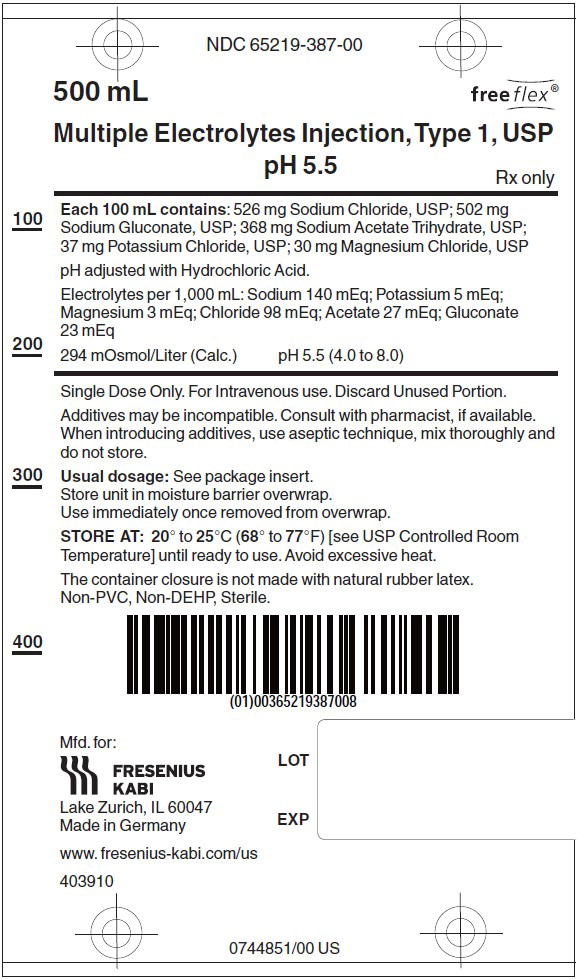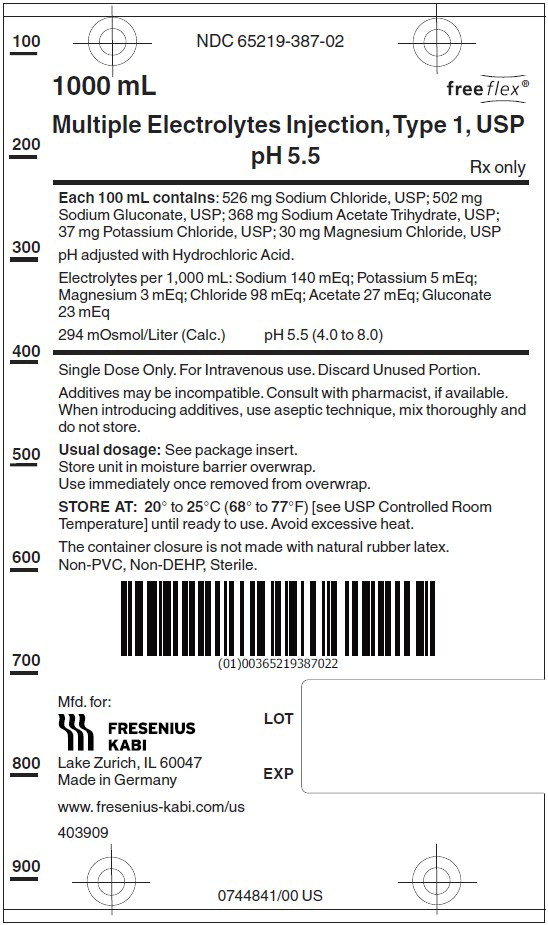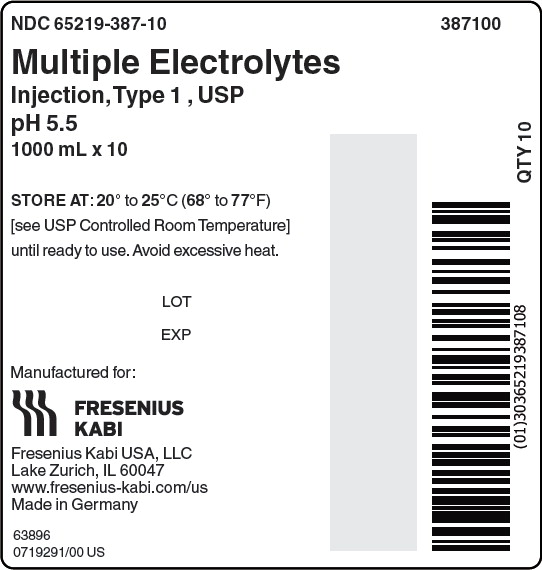Label: MULTIPLE ELECTROLYTES PH 5.5- sodium chloride, sodium gluconate, sodium acetate, potassium chloride and magnesium chloride injection, solution
- NDC Code(s): 65219-387-00, 65219-387-02, 65219-387-05, 65219-387-10
- Packager: Fresenius Kabi USA, LLC
- Category: HUMAN PRESCRIPTION DRUG LABEL
- DEA Schedule: None
- Marketing Status: Abbreviated New Drug Application
Drug Label Information
Updated November 10, 2022
If you are a consumer or patient please visit this version.
- Download DRUG LABEL INFO: PDF XML
- Official Label (Printer Friendly)
- SPL UNCLASSIFIED SECTION
-
DESCRIPTION
Multiple Electrolytes Injection, Type 1, USP, pH 5.5 is a sterile, nonpyrogenic isotonic solution in a single dose container for intravenous administration. Each 100 mL contains 526 mg of Sodium Chloride, USP (NaCl); 502 mg of Sodium Gluconate (C6H11NaO7); 368 mg of Sodium Acetate Trihydrate, USP (C2H3NaO2•3H2O); 37 mg of Potassium Chloride, USP (KCl); and 30 mg of Magnesium Chloride, USP (MgCl2•6H2O). It contains no antimicrobial agents. The pH is adjusted with hydrochloric acid. The pH is 5.5 (4.0 to 8.0).
Multiple Electrolytes Injection, Type 1, USP, pH 5.5 administered intravenously has value as a source of water, electrolytes, and calories. One liter has an ionic concentration of 140 mEq sodium, 5 mEq potassium, 3 mEq magnesium, 98 mEq chloride, 27 mEq acetate, and 23 mEq gluconate. The osmolarity is 294 mOsmol/L (calc). Normal physiologic osmolarity range is approximately 280 to 310 mOsmol/L. The caloric content is 21 kcal/L.
The flexible plastic container is fabricated from a specially formulated non-plasticized, film containing polypropylene and thermoplastic elastomers (freeflex® bag). The amount of water that can permeate from inside the container into the overwrap is insufficient to affect the solution significantly. Solutions in contact with the plastic container can leach out certain of its chemical components in very small amounts within the expiration period. However, the safety of the plastic has been confirmed in tests in animals according to USP biological tests for plastic containers as well as by tissue culture toxicity studies.
-
CLINICAL PHARMACOLOGY
Multiple Electrolytes Injection, Type 1, USP, pH 5.5 has value as a source of water and electrolytes. It is capable of inducing diuresis depending on the clinical condition of the patient.
Multiple Electrolytes Injection, Type 1, USP, pH 5.5 produces a metabolic alkalinizing effect. Acetate and gluconate ions are metabolized ultimately to carbon dioxide and water, which requires the consumption of hydrogen cations.
- INDICATIONS AND USAGE
-
CONTRAINDICATIONS
Multiple Electrolytes Injection, Type 1, USP, pH 5.5 is contraindicated in patients with a known hypersensitivity to the product. See WARNINGS.
-
WARNINGS
Hypersensitivity Reactions
Hypersensitivity and infusion reactions have been reported with Multiple Electrolytes Injection, Type 1, USP. See ADVERSE REACTIONS.
Stop the infusion immediately if signs or symptoms of a hypersensitivity reaction develop, such as tachycardia, chest pain, dyspnea and flushing. Institute appropriate therapeutic countermeasures as clinically indicated.
Electrolyte Imbalances
Fluid Overload
Depending on the volume and rate of infusion, the intravenous administration of Multiple Electrolytes Injection, Type 1, USP can cause electrolyte disturbances such as overhydration and congested states, including pulmonary congestion and edema.
Avoid Multiple Electrolytes Injection, Type 1, USP in patients with or at risk for fluid and/or solute overloading. If use cannot be avoided, monitor fluid balance, electrolyte concentrations, and acid base balance, as needed and especially during prolonged use.
Hyponatremia
Multiple Electrolytes Injection, Type 1, USP may cause hyponatremia. Hyponatremia can lead to acute hyponatremic encephalopathy characterized by headache, nausea, seizures, lethargy, and vomiting. Patients with brain edema are at particular risk of severe, irreversible and life-threatening brain injury.
The risk of hospital-acquired hyponatremia is increased in patients with cardiac or pulmonary failure, and in patients with non-osmotic vasopressin release (including SIADH) treated with high volume of hypotonic Multiple Electrolytes Injection, Type 1, USP.
Avoid Multiple Electrolytes Injection, Type 1, USP in hypervolemic or overhydrated patients. If use cannot be avoided, monitor serum sodium concentrations.
Hypernatremia
Hypernatremia may occur with Multiple Electrolytes Injection, Type 1, USP. Conditions that may increase the risk of hypernatremia, fluid overload and edema (central and peripheral), include patients with: primary hyperaldosteronism; secondary hyperaldosteronism associated with, for example, hypertension, congestive heart failure, liver disease (including cirrhosis), renal disease (including renal artery stenosis, nephrosclerosis); and pre-eclampsia.
Certain medications, such as corticosteroids or corticotropin, may also increase risk of sodium and fluid retention, see PRECAUTIONS.
Avoid Multiple Electrolytes Injection, Type 1, USP in patients with, or at risk for, hypernatremia. If use cannot be avoided, monitor serum sodium concentrations.
Hypermagnesemia
Avoid solutions containing magnesium, including Multiple Electrolytes Injection, Type 1, USP in patients with or predisposed to hypermagnesemia, including patients with severe renal impairment and those patients receiving magnesium therapy (e.g., treatment of eclampsia and myasthenia gravis).
Multiple Electrolytes Injection, Type 1, USP is not indicated for the treatment of hypomagnesemia.
Acidosis
Multiple Electrolytes Injection, Type 1, USP is not for use for the treatment of lactic acidosis or severe metabolic acidosis in patients with severe liver and/or renal impairment.
Alkalosis
Excess administration of Multiple Electrolytes Injection, Type 1, USP can result in metabolic alkalosis. Avoid Multiple Electrolytes Injection, Type 1, USP in patients with alkalosis or at risk for alkalosis.
Multiple Electrolytes Injection, Type 1, USP is not indicated for the treatment of hypochloremic hypokalemic alkalosis. Avoid use in patients with hypochloremic hypokalemic alkalosis.
Hypocalcemia
Multiple Electrolytes Injection, Type 1, USP contains no calcium, and an increase in plasma pH due to its alkalinizing effect may lower the concentration of ionized (not-protein bound) calcium. Avoid Multiple Electrolytes Injection, Type 1, USP in patients with hypocalcemia.
Hyperkalemia
Potassium-containing solutions, including Multiple Electrolytes Injection, Type 1, USP may increase the risk of hyperkalemia.
Patient's at increased risk of developing hyperkalemia include those:
- With conditions predisposing to hyperkalemia and/or associated with increased sensitivity to potassium, such as patients with severe renal impairment, acute dehydration, extensive tissue injury or burns, certain cardiac disorders such as congestive heart failure.
- Treated concurrently or recently with agents or products that cause or increase the risk of hyperkalemia (see PRECAUTIONS).
Avoid Multiple Electrolytes Injection, Type 1, USP in patients with, or at risk for hyperkalemia If use cannot be avoided, monitor serum potassium concentrations.
Although Multiple Electrolytes Injection, Type 1, USP has a potassium concentration similar to the concentration in plasma, it is insufficient to produce a useful effect in case of severe potassium deficiency; therefore, it is not indicated for correction of severe potassium deficiency.
-
PRECAUTIONS
Patients with Renal Impairment
In patients with renal impairment, administration of Multiple Electrolytes Injection, Type 1, USP may result in sodium and/or potassium or magnesium retention (see WARNINGS). Avoid Multiple Electrolytes Injection, Type 1, USP in patients with severe renal impairment or conditions that may cause sodium and/or potassium retention or magnesium retention, fluid overload, or edema. If use cannot be avoided, monitor patients with severe renal impairment for development of these adverse reactions.
Drug Interactions
Other Products that Affect Fluid and/or Electrolyte Balance
Administration of Multiple Electrolytes Injection, Type 1, USP to patients treated concomitantly with drugs associated with sodium and fluid retention may increase the risk of hypernatremia and volume overload. Avoid use of Multiple Electrolytes Injection, Type 1, USP in patients receiving such products, such as corticosteroids or corticotropin. If use cannot be avoided, monitor serum electrolytes, fluid balance and acid-base balance.
Other Drugs that Increase the Risk of Hyponatremia
Administration of Multiple Electrolytes Injection, Type 1, USP in patients treated concomitantly with medications associated with hyponatremia may increase the risk of developing hyponatremia.
Avoid use of Multiple Electrolytes Injection, Type 1, USP in patients receiving products, such as diuretics, and certain antiepileptic and psychotropic medications. Drugs that increase the vasopressin effect reduce renal electrolyte free water excretion and may also increase the risk of hyponatremia following treatment with intravenous fluids. If use cannot be avoided, monitor serum sodium concentrations.
Lithium
Renal clearance of lithium may be increased during administration of Multiple Electrolytes Injection, Type 1, USP. Monitor serum lithium concentrations during concomitant use.
Other Products that Increase the Risk of Hyperkalemia
Because of its potassium content, avoid use of Multiple Electrolytes Injection, Type 1, USP in patients receiving products that can cause hyperkalemia or increase the risk of hyperkalemia, such as potassium sparing diuretics, ACE inhibitors, angiotensin II receptor antagonists, or the immunosuppressants tacrolimus and cyclosporine. If use cannot be avoided, monitor serum potassium concentrations.
Drugs with pH Dependent Renal Elimination
Due to its alkalinizing effect (formation of bicarbonate), Multiple Electrolytes Injection, Type 1, USP may interfere with the elimination of drugs with pH dependent renal elimination. Renal clearance of acidic drugs may be increased. Renal clearance of alkaline drugs may be decreased.
Drug/Laboratory Test Interactions
There have been reports of positive test results using the Bio-Rad Laboratories Platelia Aspergillus EIA test in patients receiving gluconate containing Multiple Electrolytes Injection, Type 1, USP solutions. These patients were subsequently found to be free of Aspergillus infection. Therefore, positive test results for this test in patients receiving gluconate containing Multiple Electrolytes Injection, Type 1, USP solutions should be interpreted cautiously and confirmed by other diagnostic methods.
Carcinogenesis, Mutagenesis, Impairment of Fertility
Studies with Multiple Electrolytes Injection, Type 1, USP have not been performed to evaluate carcinogenic potential, mutagenic potential, or effects on fertility.
Pregnancy
Teratogenic Effects
Animal reproduction studies have not been conducted with Multiple Electrolytes Injection, Type 1, USP. It is also not known whether Multiple Electrolytes Injection, Type 1, USP can cause fetal harm when administered to a pregnant woman or can affect reproduction capacity. Multiple Electrolytes Injection, Type 1, USP should be given to a pregnant woman only if clearly needed.
Nursing Mothers
It is not known where this drug is excreted in human milk. Because many drugs are excreted in human milk, caution should be exercised when Multiple Electrolytes Injection, Type 1, USP is administered to a nursing mother.
Pediatric Use
The use of Multiple Electrolytes Injection, Type 1, USP in pediatric patients is based on clinical practice.
Geriatric Use
Geriatric patients are at increased risk of developing electrolyte imbalances. Multiple Electrolytes Injection, Type 1, USP is known to be substantially excreted by the kidney, and the risk of toxic reactions to this drug may be greater in patients with impaired renal function. Therefore, dose selection for an elderly patient should be cautious, usually starting at the low end of the dosing range, reflecting the greater frequency of decreased hepatic, renal, or cardiac function, and of concomitant disease or other drug therapy. Consider monitoring renal function in elderly patients.
-
ADVERSE REACTIONS
Post-marketing Adverse Reactions
The following adverse reactions associated with the use of Multiple Electrolytes Injection, Type 1, USP were identified in clinical trials or postmarketing reports. Because postmarketing reactions were reported voluntarily from a population of uncertain size, it is not always possible to estimate their frequency, reliably, or to establish a causal relationship to drug exposure.
Hypersensitivity and Infusion Reactions: tachycardia, palpitations, chest pain, chest discomfort, dyspnea, flushing, hyperemia, asthenia, feeling abnormal, piloerection, edema peripheral, pyrexia, hypotension, wheezing, urticaria, cold sweat, chills.
General Disorders and Administration Site Conditions: infusion site pain, burning sensation.
Metabolism and nutrition disorders: hyperkalemia, hyponatremia.
Nervous System Disorders: hyponatremic encephalopathy.
To report SUSPECTED ADVERSE REACTIONS, contact Fresenius Kabi USA, LLC at 1-800-551-7176 or FDA at 1-800-FDA-1088 or www.fda.gov/medwatch.
-
OVERDOSAGE
Excessive administration of Multiple Electrolytes Injection, Type 1, USP, pH 5.5 can cause:
- fluid overload with a risk of edema (peripheral and/or pulmonary), particularly when renal sodium excretion is impaired.
- hypernatremia and hyperkalemia, especially in patients with severe renal impairment.
- hypermagnesemia. See WARNINGS and ADVERSE REACTIONS
- metabolic alkalosis with or without hypokalemia and decreased ionized serum calcium and magnesium concentrations.
When assessing an overdose, any additives in the solution must also be considered.
The effects of an overdose may require immediate medical attention and treatment.
Interventions include discontinuation of Multiple Electrolytes Injection, Type 1, USP, pH 5.5, dose reduction, and other measures as indicated for the specific clinical constellation (e.g., monitoring of fluid balance, electrolyte concentrations and acid base balance).
-
DOSAGE AND ADMINISTRATION
Important Administration Instructions
- Multiple Electrolytes Injection, Type 1, USP, pH 5.5 is intended for intravenous administration using sterile equipment.
- Do not connect flexible plastic containers in series in order to avoid air embolism due to possible residual air contained in the primary container.
- Set the vent to the closed position on a vented intravenous administration set to prevent air embolism.
- Use a dedicated line without any connections to avoid air embolism.
- Do not pressurize intravenous solutions contained in flexible plastic containers to increase flow rates in order to avoid air embolism due to incomplete evacuation of residual air in the container.
- Prior to infusion, visually inspect the solution for particulate matter and discoloration. The solution should be clear and there should be no precipitates. Do not administer unless solution is clear, and container is undamaged.
- Multiple Electrolytes Injection, Type 1, USP, pH 5.5 is compatible with blood or blood components. It may be administered prior to or following the infusion of blood through the same administration set (i.e., as a priming solution), added to or infused concurrently with blood components, or used as a diluent in the transfusion of packed erythrocytes. Multiple Electrolytes Injection, Type 1, USP, pH 5.5 and 0.9% Sodium Chloride Injection, USP are equally compatible with blood or blood components.
Dosing Information
The choice of product, dosage, volume, rate, and duration of administration is dependent upon the age, weight and clinical condition of the patient and concomitant therapy, and administration should be determined by a physician experienced in intravenous fluid therapy.
Introduction of Additives
Additives may be incompatible.
Evaluate all additions to the plastic container for compatibility and stability of the resulting preparation. Consult with a pharmacist, if available.
If, in the informed judgment of the physician, it is deemed advisable to introduce additives, use aseptic technique. Mix thoroughly when additives have been introduced. After addition, if there is a discoloration and/or the appearance of precipitates, insoluble complexes or crystals, do not use. Do not store solutions containing additives. Discard any unused portion.
-
HOW SUPPLIED
Multiple Electrolytes Injection, Type 1, USP, pH 5.5 in freeflex® plastic containers is available as shown below:
Product Code Unit of Use Unit of Sale 387150 NDC 65219-387-00
One 500 mL freeflex® BagNDC 65219-387-05
Package of 20 freeflex® Bags387100 NDC 65219-387-02
One 1000 mL freeflex® BagNDC 65219-387-10
Package of 10 freeflex® BagsExposure of pharmaceutical products to heat should be minimized. Avoid excessive heat. Store at 20° to 25°C (68° to 77°F). [See USP Controlled Room Temperature.] Brief exposure up to 40°C does not adversely affect the product.
The container closure is not made with natural rubber latex. Non-PVC, Non-DEHP, Sterile.
-
INSTRUCTIONS FOR USE
For Information on Risk of Air Embolism – see DOSAGE AND ADMINISTRATION.
Check solution container composition, lot number, and expiry date.
Parenteral drug products should be inspected visually for particulate matter and discoloration prior to administration, whenever solution and container permit.
Do not use solution containers in series connections.
Do not remove solution container from its overwrap until immediately before use.
The intact port caps provide visual tamper evidence. Do not use if a port cap is prematurely removed. Maintain strict aseptic technique during handling.
TO OPEN
- Always inspect the solution container before and after removal from the overwrap.
- Place the solution container on a clean, flat surface. Using the pre-cut corner tabs, peel open the overwrap and remove the solution container from the overwrap.
- Check the solution container for leaks by squeezing firmly. If leaks are found, discard as sterility may be impaired.
- Do not use if the solution is cloudy or a precipitate is present.
TO PREPARE FOR ADMINISTRATION
- Immediately before inserting the infusion set, break off BLUE Infusion Port Cap with the arrow pointing away from the solution container.
- Use a non-vented infusion set or close the air-inlet on a vented set.
- Close the roller clamp of the infusion set.
- Hold the base of BLUE Infusion Port, twist and push the spike until the spike is fully inserted. Refer to complete directions accompanying set.
- The BLUE infusion port contains a self‐sealing septum that helps prevent leakage after removing the spike. The infusion port is not intended to be spiked more than once.
- Suspend solution container from hanger hole.
If supplemental medication is desired, follow directions below.
TO ADD MEDICATION BEFORE SOLUTION ADMINISTRATION
- Identify WHITE Injection Port with arrow pointing toward solution container.
- Immediately before injecting additives, break off WHITE Injection Port Cap with the arrow pointing toward solution container.
- Hold base of WHITE Injection Port.
- Insert needle (18 to 23 gauge) through the center of WHITE Injection Port's septum and inject additives.
- Mix solution container contents thoroughly. For high density medication such as potassium chloride, squeeze ports while ports are upright and mix thoroughly.
TO ADD MEDICATION DURING SOLUTION ADMINISTRATION
- Close the clamp on the set.
- Identify WHITE Injection Port with arrow pointing toward solution container.
- Immediately before injecting additives, break off WHITE Injection Port cap with the arrow pointing toward solution container.
- Hold base of WHITE Injection Port.
- Insert needle (18 to 23 gauge) through the center of WHITE Injection Port's septum and inject additives.
- Remove container from IV pole and/or turn to an upright position.
- Evacuate both ports by squeezing them while container is in the upright position.
- Mix solution container contents thoroughly.
- Return container to in use position and continue administration.
For Single Use Only. Discard unused portion.
Manufactured for:
Lake Zurich, IL 60047
Made in Germany
451766
www.fresenius-kabi.com/us
Issued: September 2022
-
PACKAGE LABEL - PRINCIPAL DISPLAY – Multiple Electrolytes Injection, Type 1, USP pH 5.5 500 mL Bag Label
500 mL
NDC 65219-387-00
Multiple Electrolytes Injection, Type 1, USP pH 5.5Rx only
Each 100 mL contains: 526 mg Sodium Chloride, USP; 502 mg Sodium Gluconate, USP; 368 mg Sodium Acetate Trihydrate, USP; 37 mg Potassium Chloride, USP; 30 mg Magnesium Chloride, USP
pH adjusted with Hydrochloric acid.
Electrolytes per 1,000 mL: Sodium 140 mEq; Potassium 5 mEq;
Magnesium 3 mEq; Chloride 98 mEq; Acetate 27 mEq; Gluconate
23 mEq
294 mOsmol/Liter (Calc.) pH 5.5 (4.0 to 8.0)
- PACKAGE LABEL – PRINCIPAL DISPLAY – Multiple Electrolytes Injection, Type 1, USP pH 5.5 500 mL Shipper Label
-
PACKAGE LABEL - PRINCIPAL DISPLAY – Multiple Electrolytes Injection, Type 1, USP pH 5.5 1000 mL Bag Label
1000 mL
NDC 65219-387-02
Multiple Electrolytes Injection, Type 1, USP pH 5.5Rx only
Each 100 mL contains: 526 mg Sodium Chloride, USP; 502 mg Sodium Gluconate, USP; 368 mg Sodium Acetate Trihydrate, USP; 37 mg Potassium Chloride, USP; 30 mg Magnesium Chloride, USP
pH adjusted with Hydrochloric acid.
Electrolytes per 1,000 mL: Sodium 140 mEq; Potassium 5 mEq; Magnesium 3 mEq; Chloride 98 mEq; Acetate 27 mEq; Gluconate 23 mEq
294 mOsmol/Liter (Calc.) pH 5.5 (4.0 to 8.0)
- PACKAGE LABEL – PRINCIPAL DISPLAY – Multiple Electrolytes Injection, Type 1, USP pH 5.5 1000 mL Shipper Label
-
INGREDIENTS AND APPEARANCE
MULTIPLE ELECTROLYTES PH 5.5
sodium chloride, sodium gluconate, sodium acetate, potassium chloride and magnesium chloride injection, solutionProduct Information Product Type HUMAN PRESCRIPTION DRUG Item Code (Source) NDC:65219-387 Route of Administration INTRAVENOUS Active Ingredient/Active Moiety Ingredient Name Basis of Strength Strength SODIUM CHLORIDE (UNII: 451W47IQ8X) (SODIUM CATION - UNII:LYR4M0NH37, CHLORIDE ION - UNII:Q32ZN48698) SODIUM CHLORIDE 526 mg in 100 mL SODIUM GLUCONATE (UNII: R6Q3791S76) (GLUCONIC ACID - UNII:R4R8J0Q44B, SODIUM CATION - UNII:LYR4M0NH37) SODIUM GLUCONATE 502 mg in 100 mL SODIUM ACETATE (UNII: 4550K0SC9B) (ACETATE ION - UNII:569DQM74SC, SODIUM CATION - UNII:LYR4M0NH37) SODIUM ACETATE 368 mg in 100 mL POTASSIUM CHLORIDE (UNII: 660YQ98I10) (POTASSIUM CATION - UNII:295O53K152, CHLORIDE ION - UNII:Q32ZN48698) POTASSIUM CHLORIDE 37 mg in 100 mL MAGNESIUM CHLORIDE (UNII: 02F3473H9O) (MAGNESIUM CATION - UNII:T6V3LHY838, CHLORIDE ION - UNII:Q32ZN48698) MAGNESIUM CHLORIDE 30 mg in 100 mL Inactive Ingredients Ingredient Name Strength Hydrochloric acid (UNII: QTT17582CB) Packaging # Item Code Package Description Marketing Start Date Marketing End Date 1 NDC:65219-387-05 20 in 1 CASE 10/21/2022 1 NDC:65219-387-00 500 mL in 1 BAG; Type 2: Prefilled Drug Delivery Device/System (syringe, patch, etc.) 2 NDC:65219-387-10 10 in 1 CASE 10/21/2022 2 NDC:65219-387-02 1000 mL in 1 BAG; Type 2: Prefilled Drug Delivery Device/System (syringe, patch, etc.) Marketing Information Marketing Category Application Number or Monograph Citation Marketing Start Date Marketing End Date ANDA ANDA215370 07/01/2021 Labeler - Fresenius Kabi USA, LLC (013547657) Establishment Name Address ID/FEI Business Operations Fresenius Kabi Deutschland GmbH 506719546 MANUFACTURE(65219-387) , ANALYSIS(65219-387) , API MANUFACTURE(65219-387)

